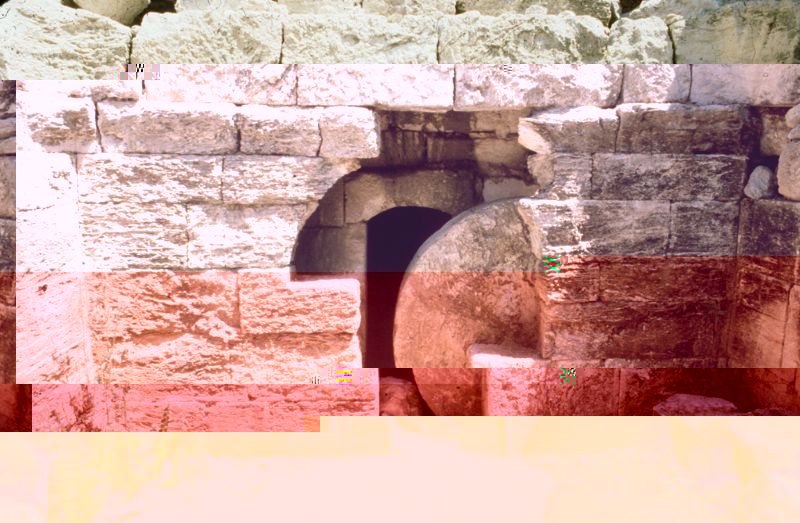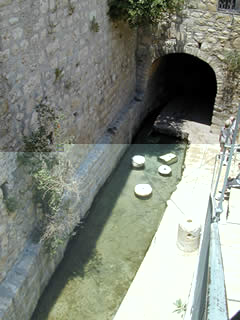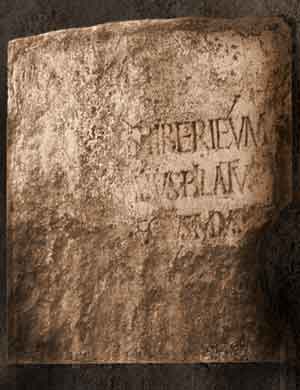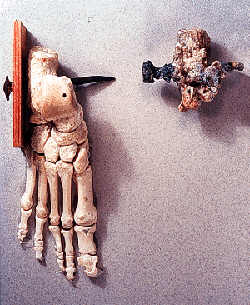
ichthus.info
-
Challenges from Liberal Scholars....
- For more than 100 years, opponents of Bibilical inspiration -
especially the liberal German schools of higher criticism lead
by Julius Wellhausen
- denied the crucifixion.
They have argued that much - if not most - of what is written in
the New Testament is merely "commentary".
And that the Biblical text were "invented stories" and the words
were "placed in the mouths of Jesus and the apostles".
These liberal scholars maintained that the events did not
actually occur....
For example, one of the assertions of critics was that:
-
"there was no
physical evidence that crucifixion was used by the Romans as capital
punishment in the time of the early century - and therefore,
the story of the crucifixion of Jesus was probably a myth....
- For more than 100 years, opponents of Bibilical inspiration -
especially the liberal German schools of higher criticism lead
by Julius Wellhausen
- denied the crucifixion.
They have argued that much - if not most - of what is written in
the New Testament is merely "commentary".
And that the Biblical text were "invented stories" and the words
were "placed in the mouths of Jesus and the apostles".
These liberal scholars maintained that the events did not
actually occur....
-
Archeology
- Archeology has provided many evidences in support to the Biblical narative - that what is reported in the Bible is not "just a story from someone's imagination", but are based on historical facts
- The following is a only a partial list of the evidences.....
Evidence for the HISTORICAL truth of the Biblical naratives
-
Capernaum, Bethsaida, Chorazin and Tiberias
- The Gospels mentioned these 4 neighboring cities along the Sea of Galilee
- These cities disapppeared from history and their locations remained missing for centuries
- Only recently, archaeology has recovered their possible locations:
- Tell Hum is believed to be Capernaum
- A site at a tell (mountain) 1.5 miles north of the Galilean shoreline is believed to be Bethsaida
- Tell Khirbit Kerezah, 2.5 miles northwest of Capernaum, is thought to be Chorazin
-
- Many Christian were probably not aware that skeptics have been
saying for a long time that Nazareth never existed during
the time of Jesus' lifetime....
(Note: Nazareth does exist NOW, it's quite big even -
that's because Emperor Constantine built
a church there in the 4th century and became
a center of Christian pilgrimages.
The skeptics were saying that Nazareth did not exist when Jesus was alive - so they are saying that Nazareth was built later !!!)
This is an indirect claim that the New Testament is nothing more than a fairy tale, because if Nazareth did not exist, Jesus never grew up in Nazareth.... so Jesus never existed.... In other words, Jesus is just as real as Peter Pan....
- Surely, you know that the New Testament mentioned Nazareth
(Jesus is often called "Jesus of Nazareth" because
He grew up there)
However, no acient historians or geographers before around 400 AD
mentioned Nazareth....
The earliest appearance of Nazareth in Jewish literature was in a poem written around 700 AD
-
Source: Case for Christ, pp 102
- It is no wonder that Nazareth was not mentioned by
historians:
-
John 1:46 -- And Nathaniel said to him (Philip):
"Can there be any good thing come out of Nazareth ?"
Historians write about kings and emperors; not about people in rat holes...
- The evidence that Nazareth DOES
existed in Jesus' time
came from the finding of a
list in Aramaic (Jewish language)
describing a number of
famlies of priests
that were no longer needed
in 70 AD.
It is the custom to
select priests
from every town and city to
serve in the temple,
When the temple was destroyed in 70 AD, the priests were no longer needed....
Archaelogists have discovered a list of 24 families of priests who were relocated after the temple's destruction and one of the family was registered as having moved to .... you guessed it.... Nazareth !
So Nazareth does exist in 70 A.D. !
- Nazareth:
- We know now that Nazareth is about 60 acres with a max. population of about 400. They think the population of Nazareth was about 80 in Jesus' time.... (Now you may understand better why Nathaniel said "Can there be any good thing come out of Nazareth ?")
- Many Christian were probably not aware that skeptics have been
saying for a long time that Nazareth never existed during
the time of Jesus' lifetime....
(Note: Nazareth does exist NOW, it's quite big even -
that's because Emperor Constantine built
a church there in the 4th century and became
a center of Christian pilgrimages.
-
Herod the not-so Great....
- The Gospel of Matthew tells us the Herod the Great - the ruler when Jesus was born - was a cruel man; he has ordered the killing of all infants when Jesus escaped.
- Archeological finding now tells us that
his slaughter of innocents is consistent
with the historical facts
that describe his character:
- Herod was indeed suspicious of anyone whom he thought may take his throne.
- His list of victims included one of his ten wives, who was his favorite, three of his own sons, a high priest, an ex-king, and two of his sister's husbands.
-
The Pool of Bethesda
- In John 5:1-15 Jesus heals a man at the Pool of Bethesda. John gave the precise location and a description of the pool as having 5 porticoes (pillars):
-
For a long time, skeptics cited this as an example of John being inaccurate because no such place had been found....John 5:1 --- After this there was a feast of the Jews, and Jesus went up to Jerusalem. Now there is a pool at the Sheep Gate at Jerusalem, which is called in Hebrew Bethesda, having five porches. In these lay a great multitude of those who were sick, of blind, lame, withered, waiting for the moving of the water. For an angel went down at a certain time into the pool and troubled the water. Then whoever first stepped in after the troubling of the water was made whole of whatever disease he had. And a certain man was there, who had an infirmity thirty-eight years. When Jesus saw him lying, and knowing that he had spent much time, He said to him, Do you desire to be made whole? The infirm man answered Him, Sir, when the water is troubled, I have no one to put me into the pool. But while I am coming, another steps down before me. Jesus says to him, Rise, take up your bed and walk.
- The fact is, John did not need to describe the details of
the pool (with its 5 pillars) in his gospel, and the fact
that he did, made his account vulnerable to contest.
But archaeology has recently
vindicated John's testimony and accuracy:
-
40 feet underground, archaeologists discovered a pool
with five porticoes, and the description of the surrounding
area matches John's description.

-
The Pool of Siloam
- In 9:7 John mentions another long disputed site: the Pool of Siloam near the Temple in Jerusalem.
- However, this pool was also discovered in 1897, upholding the accuracy of John.
-

-
Pontius Pilate....
- Evidence for Pontius Pilate, the governor who presided over the trial of Jesus, was discovered in Caesarea Maritama.
- In 1961, an Italian archaeologist named Antonio Frova uncovered a fragment of a plaque that was used as a section of steps leading to the Caesarea Theater:
-

- Line 1: TIBERIEUM
- Line 2: (PON)TIUS PILATUS
- Line 3: (PRAEF)ECTUS IUDA(EAE)
-
The rolling stone tombs....
- They have found some:
-

-
The crucifixion evidence....
- For long time, skeptics were saying that there is
no evidence that
crucifixion was used in Jesus' time
(They knew that Romans used crucifixion earlier to kill slaves
in a slave revolt led by Spartacus, but these skeptics claim
that Romans have abolish its use before Jesus time)
- This claim has also been refuted by Archaeology....
The year was 1968....
they found an ossuary (burial box) in a
Herodian tomb containing the bones of a young man who
has been crucified
- the ossuary is dated around 100 AD
-
The name inscribed on the ossuary was "Yehohanan ben Hagakol".
The nail (of the crucifixion) had been driven through
the man's heel into the cross and the nail had entered a
knot in the wood.
The nail is stuck and cannot be removed from the wooden cross.
The problem was solved by removing some part of the wooded cross along with the nail with the body.
The nail was found with the bones in the ossuary...

- For long time, skeptics were saying that there is
no evidence that
crucifixion was used in Jesus' time
(They knew that Romans used crucifixion earlier to kill slaves
in a slave revolt led by Spartacus, but these skeptics claim
that Romans have abolish its use before Jesus time)
-
Breaking of the legs of the crucified...
- John's gospel (John 19:31-33) records that in order
to expedite the death of a prisoner,
executioners broke the legs of the victim (in order for
a crucified victim to breath, he needs to push himself up
with his feet. So when one's feet is broken, the crucified victim
will die very quickly)
John 19:32 --- Then the soldiers came and broke the legs of the first, and of the other who was crucified with Him. - Yohan's legs were found crushed by a blow,
broken below the knee....
This is again consistent
with the description in John's Gospel
- NOTE:
The Dead Sea Scrolls tell that both Jews and Romans
abhorred crucifixion due to its
cruelty
and humiliation -
just go see Mel Gibson's film "Passion"
which is historically accurate
The scrolls also state it was a punishment reserved for slaves and any who challenged the ruling powers of Rome.
- John's gospel (John 19:31-33) records that in order
to expedite the death of a prisoner,
executioners broke the legs of the victim (in order for
a crucified victim to breath, he needs to push himself up
with his feet. So when one's feet is broken, the crucified victim
will die very quickly)
-
Darkness and earth quake when Jesus died....
- During Jesus' crucifixion, darkness covered the land of Israel for
three hours... this was recorded by three of the Gospel
writers:
Matthew 27:45 --- "Now from the 6th hour there occurred darkness over all the land until the 9th hour."
Mark 15:33 --- "Now when the 6th hour had come, it became dark over all the land until the 9th hour."
Luke 23:44-45 --- "It was now about the 6th hour, and darkness came over all the land until the 9th hour, the sun failing." - Archaeology has found some indications that this darkness was GLOBAL - observed throughout the civilized world... furthermore, the earth quake was also global....
- Evidence from the Greek historian Thallus:
- The historian Thallus in 52 A.D.
wrote about a darkness....
however, his writing did not survive to us....
But.... his work was cited
by Julius Africanus' (160-240 AD) work, "Chronography":
On the whole world there pressed a most fearful darkness; and the rocks were rent by an earthquake, and many places in Judea and other districts were thrown down. This darkness Thallus, in the third book of his History, calls, as appears to me without reason, an eclipse of the sun. For the Hebrews celebrate the passover on the 14th day according to the moon, and the passion of our Saviour fails on the day before the passover; but an eclipse of the sun takes place only when the moon comes under the sun. And it cannot happen at any other time but in the interval between the first day of the new moon and the last of the old, that is, at their junction: how then should an eclipse be supposed to happen when the moon is almost diametrically opposite the sun?
In: Julius Africanus, Chronography, 18:1.
- Here is an explanation of what Africanus was talking
about
Thallus apparently has written about a darkness that occured around
the passover, and Thallus explained that this darkness was
probably caused by a solar eclipse....
Julius Africanus says that this is not possible, because a darkness that is caused by a solar eclipse occurs when the sun, earth and moon position are as follows:

Jewish passover always occured on the 14th day of a lunar calendar which is always full moon (like the lunar festival of the Chinese). And the Sun-moon position during a full moon is always as follows:

Therefore, the darkness that Thallus said he saw can't be caused by a solar eclipse....
- The historian Thallus in 52 A.D.
wrote about a darkness....
however, his writing did not survive to us....
But.... his work was cited
by Julius Africanus' (160-240 AD) work, "Chronography":
-
Evidence from the Roman historian Phlegon:
- The Roman historian Phlegon apparently has also written about a darkness around Jesus' crucifixion
- Plegon's writing on history is known as "OLYMPIADES".
The reference may be found in "Fragmenta Historicum
Graecorum" (C. Muller) 1841- 1870, Volume 3, pages 603 - 624:
"In the 4th year of the 202nd Olympiad, there was a great eclipse [Greek = EKLEIPSIS] of the Sun, greater than had ever been known before, for at the 6th hour the day was changed into night and the stars were seen in the heavens. An earthquake occurred in Bythinia and overthrew a great part of the city of Nicaea"
- The first olympiad was held in 776 BC
- Each Olympiad is 4 years
- The forth year of the 202 Olympiad is 32 AD - around the time that Jesus was crucified !!!
- (We don't know the precise year that Jesus was crucified, only that it's around 30 A.D.)
- Julius Africanus' reference to Phlegon:
Phlegon records that, in the time of Tiberius Caesar, at full moon, there was a full eclipse of the sun from the sixth hour to the ninth-manifestly that one of which we speak. But what has an eclipse in common with an earthquake, the rending rocks, and the resurrection of the dead, and so great a perturbation throughout the universe? Surely no such event as this is recorded for a long period. But it was a darkness induced by God, because the Lord happened then to suffer. And calculation makes out that the period of 70 weeks, as noted in Daniel, is completed at this time. In: Julius Africanus, Chronography, 18:1.
- During Jesus' crucifixion, darkness covered the land of Israel for
three hours... this was recorded by three of the Gospel
writers:
-
Bottom Line
Let me quote Prof. McRay from "Case for Christ" pp 100:
-
"Archaeology has not produced anything that is
a contradiction to the Bible.
On the contrary:
there have been many
opinions of skeptical scholars that have been
codified into `facts' over the years
but that archaeology has shown to be wrong"
(If you let a lie go around long enough, it will become
the truth if the lie is not contested.
These skeptics had no proof that it was true
but Christians did not have any evidence to deny the things
that these skeptics were saying were lies...
so after many years, some opinions of these skeptics
became "facts" - and archaelogy is now showing that
these so called "facts" are nothing more than bloody lies.)
Δεν υπάρχουν σχόλια:
Δημοσίευση σχολίου